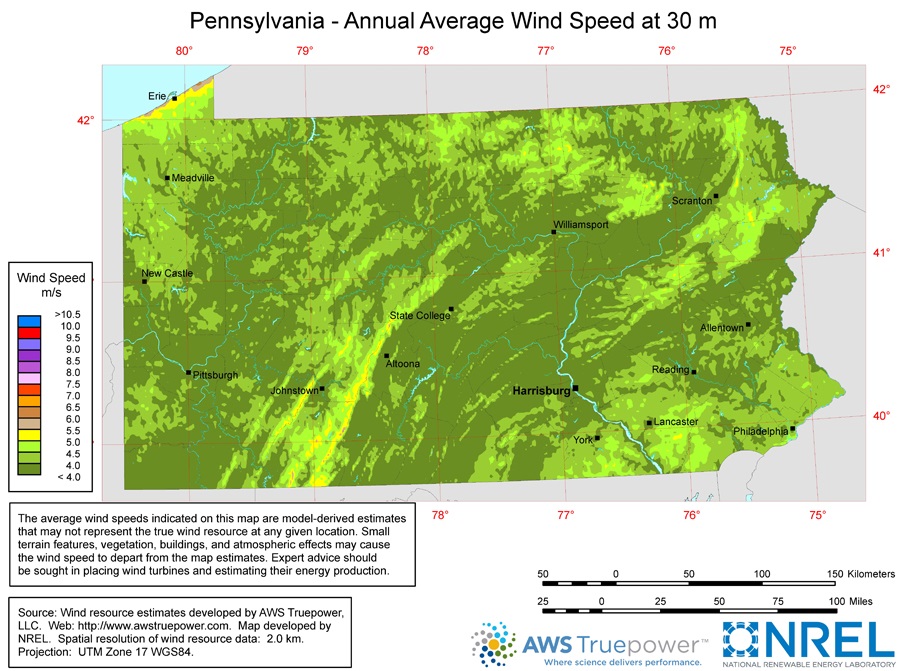This post is part of a series on energy consumption and conservation. For other posts in this series please click here.
Having the ability to harness free and abundant sources of energy to create power is a luxury when it is afforded. Unlike most sources of energy (coal, oil, etc.), wind power is a true renewable source of energy generation.
[1]According to the U.S. Department of Energy:
- It’s a clean fuel source. Wind energy doesn’t pollute the air like power plants that rely on combustion of fossil fuels, such as coal or natural gas. Wind turbines don’t produce atmospheric emissions that cause acid rain or greenhouse gasses.
- Wind energy is a domestic source of energy.The nation’s wind supply is abundant: over the past 10 years, cumulative wind power capacity in the United States increased an average of 30% per year, outpacing the 28% growth rate in worldwide capacity.
- It’s sustainable. Wind is actually a form of solar energy; winds are caused by the heating of the atmosphere by the sun, the rotation of the earth, and the earth’s surface irregularities. For as long as the sun shines and the wind blows, the energy produced can be harnessed to send power across the grid.
- Wind power is cost effective.It is one of the lowest-priced renewable energy technologies available today, costing between four and six cents per kilowatt-hour, depending upon the wind resource and project financing of the particular project.
- Wind turbines can be built on existing farms or ranches. This greatly benefits the economy in rural areas, where most of the best wind sites are found. Farmers and ranchers can continue to work the land because the wind turbines use only a fraction of the land. Wind power plant owners make rent payments to the farmer or rancher for the use of the land providing landowners with additional income.
There are currently three wind farms in operation in nearby Somerset County (Somerset, Green Mountain, and Meyersdale) which include 34 turbines producing 49.4 MW (mega-watts) of power annually. This is enough power to generate electricity for over 16,000 residential homes. Literally right down the street in Mill Run, PA stands another wind farm consisting of 10 turbines producing 15 MW of power annually; enough to power 5,000 homes.
Although the benefits of wind power are substantial, as with most types of alternative energy production, there are drawbacks to the process as well. Two major environmental concerns surrounding wind turbines are noise pollution and possible adverse effects on local wildlife. Birds and bats are especially at risk when turbines are installed.
[2]In cooperation with the government agencies and the wind industry, environmental groups have made strides in recent years in the effort to curb adverse effects to wildlife including, “investing in projects that seek to characterize and understand the impact of wind on wildlife both on land and offshore and development of cost-effective technologies that can reduce wildlife impacts at land-based and offshore wind farms.”
It’s impossible to guarantee that future wind farm development will be 100% negative-effect free with regards to environmental impacts. In the end, it’s still human intrusion onto land that we are lucky to share with all other living creatures. But until a method of power generation is invented and distributed that can produce no negative environmental effects, wind power represents a relatively viable temporary stand-in.
At this point you’re probably asking yourself, “How can I employ wind power technology if I don’t have a large area of land at my disposal?” This is a fair question. Installation of wind turbines for power generation is certainly not a viable option for every landowner. However, given the right set of circumstances, it is possible for a single-family home to be powered solely by a turbine installed on site.
Due to the elevations found in the Laurel Highlands, our area is one of the most suitable for the installation of small-wind turbines in the entire state. The map below shows the annual average wind speeds at a 30 meter height for the state of Pennsylvania. Average wind speed near 4 meters per second is usually considered suitable for small-scale wind power development.
For more detailed information regarding the feasibility of small-scale wind power in your area, visit the American Wind Energy Association’s FAQ page.
[1] “Advantages and Challenges of Wind Energy.” Office of Energy Efficiency & Renewable Energy. U.S. Department of Energy, n.d. Web. 20 Apr. 2015.
[2] “Environmental Impacts and Siting of Wind Projects.” Office of Energy Efficiency and Renewable Energy. U.S. Department of Energy, n.d. Web. 20 Apr. 2015.


